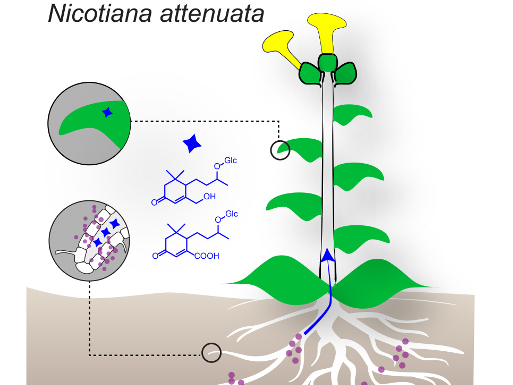Mycorrhizal markers in leaves
For the first time, researchers identified metabolites in above-ground parts of a plant that reveal its symbiosis with mycorrhizal fungi. This will advance targeted breeding endeavors.

Plants get their nutrients from the ground via their root network. However, many nutrients are nearly insoluble or very rare. Therefore, many plants live in symbiosis with root fungi that facilitate the plants’ nutrient uptake and help them thrive under extreme conditions. In fact, more than 70% of higher plants establish an association with these fungi, so-called mycorrhiza, which are believed to be more than 400 million years old. The mutualistic association allows the plant to better absorb nutrients, such as phosphate – an especially important but rare nutrient. Moreover, the symbiosis makes the plants more tolerant regarding biotic and abiotic stresses, such as insect attacks, pathogens and drought.
Mycorrhiza colonization metabolites identified in leaves
Thus, many farmers and plant breeders welcome the symbiosis. Yet, thus far, the presence of the fungi could only be detected by excavating the plant roots, which often destroys the plant. Now, researchers at the Max Planck Institute for Chemical Ecology in Jena, Germany, identified substances that accumulate in the leaves when arbuscular mycorrhizal fungi successfully colonize plant roots. The researchers describe their findings in the journal “eLIFE“: It has been known for a while that so-called blumenol C derivates are produced in the roots exclusively after colonization with the mutualistic fungi. However, until now, all attempts to find a reliable and specific leaf marker have failed. For their studies, the researchers analyzed the leaf substances with a highly sensitive technique and compared them to leaf compounds from plants without the fungal symbiosis. “Through targeted and highly sensitive mass spectrometry, we were able to find mycorrhizal-specific changes also in above-ground parts of the plants,” Ming Wang from the Jena Max Planck Institute and first author of the study describes the findings. “The blumenols are most likely produced in the roots and then transported to other parts of the plants,” adds Martin Schäfer, co-author of the study.
Plants, like the wild tobacco Nicotiana attenuata, produce blumenol C derivates (blue) in their roots when they have established a functional symbiosis with arbuscular mycorrhizal fungi (pink). The substances are transported into the leaves and can be used as foliar markers for successful fungal associations.

New tool for mycorrhizal studies
Moreover, the scientists were able to demonstrate blumenol accumulation in the leaf tissues of other plant species, including important crop varieties and vegetables. The ubiquity of markers in the shoot across distant plant families is likely due to the long common history of mycorrhizal fungi and plants, suggesting that theses markers play an important role for plants colonized with arbuscular mycorrhizal fungi.
Regardless of the function of these substances, the approach provides a robust and easy-to-apply tool with the potential to fundamentally change the future of mycorrhizal research and plant breeding. Ian Baldwin, the head of the Department of Molecular Ecology, summarizes the new possibilities: “Our diagnostic marker for the colonization with arbuscular mycorrhiza fungi can be very useful for studying mycorrhizal associations, not only for breeding programs which rely on high-throughput screenings, but also for basic research into fundamental questions about the information transferred from plant-to-plant through fungal networks.”
The discovery of foliar markers provides scientists with an easy-to-conduct tool to screen large amounts of plants for mycorrhizal associations without having to destroy them. This new tool could contribute to breeding more efficient and stress-tolerant crop varieties for sustainable agriculture.
jmr


